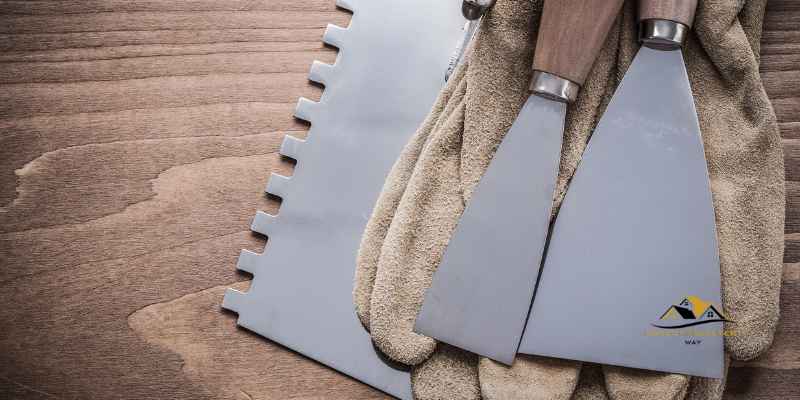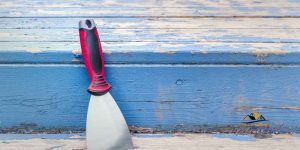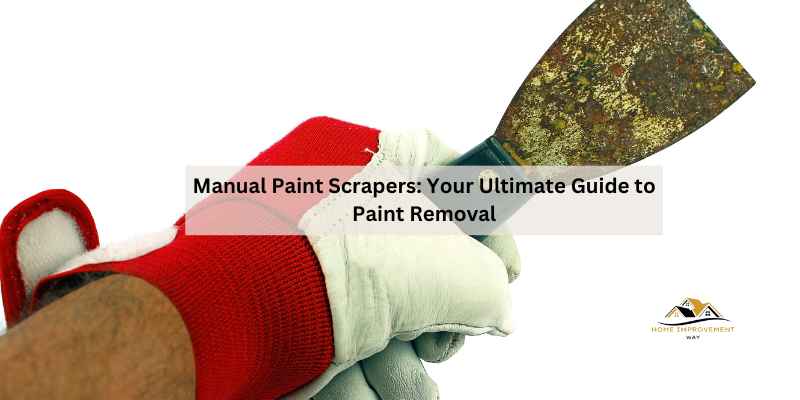Manual paint scrapers are essential tools for removing paint from various surfaces. They are designed with sharp blades to effectively scrape off old paint, preparing the surface for refinishing.
Paint scraping is a common task in home improvement and renovation projects. Whether you are removing paint from walls, furniture, or other surfaces, a manual paint scraper is a versatile and efficient tool. With a variety of scraper options available, including different blade shapes and sizes, you can find the right tool for your specific needs.
Additionally, using a manual paint scraper can be a cost-effective and environmentally friendly alternative to chemical paint strippers. We will explore the benefits of using manual paint scrapers and provide tips for selecting the best tool for your project.
Types Of Manual Paint Scrapers
When it comes to manual paint scrapers, there are several types that cater to different needs and surfaces. Let’s explore the various options available:
Putty Knife
A putty knife, with its blunt end, is suitable for scraping paint without damaging the surface.
Pull Scraper
A pull scraper is effective for removing paint by pulling it off surfaces with ease.
Push Scraper
With a push scraper, you can push and scrape paint effortlessly, making it a versatile tool.
Shave Hook
A shave hook is designed for precision scraping, making it ideal for intricate paint removal tasks.
Floor Scraper
For larger surfaces like floors, a floor scraper provides the necessary strength and durability to remove paint effectively.
How To Choose The Right Manual Paint Scraper
When it comes to choosing the right manual paint scraper, there are several factors to consider to ensure that you get the best tool for the job. Whether you’re tackling a small DIY project or a larger professional job, the right manual paint scraper can make all the difference in achieving a smooth and efficient paint removal process.
Consider The Surface
Before selecting a manual paint scraper, consider the surface you will be working on. Different surfaces may require different scraper types to avoid damage, so assess whether you’ll be working on wood, metal, or other materials.
Consider The Paint Type
It’s important to consider the type of paint you’ll be removing. Some scrapers are designed for specific paint types, such as latex or oil-based paints. Ensure that the scraper you choose is suitable for the paint you need to remove to avoid damaging the surface.
Consider The Size Of The Job
The size of the job will also determine the type of manual paint scraper you need. For smaller projects, a handheld scraper may be sufficient, while larger jobs may require a longer-handled scraper or a scraper with replaceable blades for efficiency.
Consider The Handle Grip
Comfort and grip are crucial when using a manual paint scraper for extended periods. Look for a scraper with an ergonomic handle that provides a secure grip to minimize hand fatigue and ensure precise control during paint removal.
Consider The Blade Sharpness
The sharpness of the blade is essential for effective paint removal. A dull blade can make the job more challenging and may cause damage to the surface. Look for a scraper with a sharp, durable blade that can be easily replaced or sharpened as needed for optimal performance.
Techniques For Effective Paint Scraping
To effectively scrape paint manually, use a putty knife with a blunt end to prevent surface damage. Opt for tools like the Rockler Three Blade Shavehook for efficient paint removal without harming the surface. Ensure safety and precision with quality paint scrapers like those from Stortz Tools.
Preparing The Surface
Before beginning the paint scraping process, it’s crucial to prepare the surface adequately. This involves cleaning the area to remove any dirt, dust, or debris that could interfere with the scraping. Additionally, inspect the surface for any loose or flaking paint that may need to be addressed before proceeding with the scraping.
Holding The Scraper
When using a manual paint scraper, it’s essential to hold it firmly and comfortably. Ensure a secure grip to maintain control and precision during the scraping process. This can help prevent accidental slips or injuries and allow for better maneuverability.
Angle Of The Scraper
The angle at which the scraper is held against the surface is critical for effective paint removal. Position the scraper at a shallow angle to the surface, typically around 30 to 45 degrees. This angle helps to maximize the contact area between the scraper and the paint, facilitating efficient removal.
Direction Of Scraping
When scraping paint, it’s recommended to work in the direction that allows for smooth and controlled movements. Typically, scraping in a consistent, linear motion following the grain or shape of the surface can yield the best results. Avoid abrupt or erratic movements to maintain a steady and uniform scraping process.
Use Of Heat Gun
In some cases, stubborn or old paint may require additional assistance for removal. A heat gun can be used to soften the paint, making it easier to scrape off. However, it’s important to exercise caution and follow safety guidelines when using a heat gun to avoid damage to the surface or potential hazards.

Safety Tips For Manual Paint Scraping
For safe manual paint scraping, always wear protective gear, work in well-ventilated areas, and keep tools sharp to prevent accidents. Use gentle pressure and choose the right scraper for the surface to avoid damage. Regularly clean and store your paint scrapers properly to extend their lifespan.
Wear Protective Clothing And Gear
When scraping paint manually, wear long sleeves, pants, gloves, and safety goggles to protect your skin and eyes.
Work In A Well-ventilated Area
To prevent inhaling harmful fumes, work in a well-ventilated area or use a fan to circulate the air.
Protect Surrounding Areas
Cover floors and furniture with drop cloths to prevent paint chips from spreading and causing damage.
Use A Lead Test Kit
Before scraping, test for lead paint using a lead test kit to ensure safety, especially in older homes.
Proper Disposal Of Paint Chips
Collect paint chips in a sealed bag and dispose of them properly according to local regulations to avoid environmental contamination.
Common Mistakes To Avoid When Paint Scraping
When using manual paint scrapers, it’s crucial to avoid common mistakes like applying too much pressure, which can damage the surface. Additionally, ensure the scraper blade is sharp and use the right angle to prevent unnecessary scraping. Regularly inspect the scraper blade for any signs of wear and tear to maintain its effectiveness.
Paint scraping is a crucial step when you want to give a fresh look to your walls, ceilings, or any other surface. However, it can be a challenging task if you don’t have the right tools or techniques. In this section, we will discuss some common mistakes that people make when paint scraping and how to avoid them.
Skipping surface preparation
One of the most common mistakes people make is skipping surface preparation before paint scraping. Proper surface preparation involves cleaning the surface, removing loose paint, sanding, and filling any cracks or holes. Skipping this step can make the paint scraping task more difficult and may result in uneven surfaces or damage to the wall. Always prepare the surface properly before starting to scrape the paint.
Using the wrong scraper
Using the wrong scraper is another common mistake people make. There are different types of scrapers available, such as putty knives, razor scrapers, and shave hooks, each designed for specific surfaces and types of paint. Using the wrong scraper can damage the surface or make the task more difficult. Always choose the right scraper for the job.
Applying too much pressure
Another mistake people make is applying too much pressure while scraping the paint. Applying too much pressure can damage the surface or create scratches, making it difficult to apply a new coat of paint. Always use gentle pressure and let the scraper do the work.
Scraping in the wrong direction
Scraping in the wrong direction is another mistake people make. Always scrape in the direction of the wood grain or the surface texture. Scraping in the wrong direction can damage the surface or create scratches, making it difficult to apply a new coat of paint.
Not using safety gear
Last but not least, not using safety gear is a common mistake people make. Paint scraping can create dust, debris, and fumes that can be harmful to your health. Always wear safety gear such as goggles, gloves, and a mask to protect yourself from these hazards.
In conclusion, by avoiding these common mistakes, you can make your paint scraping task more efficient, effective, and safe. Always prepare the surface, choose the right scraper, use gentle pressure, scrape in the right direction, and wear safety gear. With the right tools and techniques, you can give a fresh look to your walls, ceilings, or any other surface.
Alternative Paint Removal Methods
When it comes to removing old paint, there are several alternative methods to consider. While manual paint scrapers are a popular choice, other techniques such as chemical paint strippers, sanding, and power tools can also be effective. Each method has its own advantages and disadvantages, so it’s important to choose the right approach based on the specific needs of your project.
Chemical Paint Strippers
Chemical paint strippers are a popular choice for removing paint from various surfaces. These products work by softening the paint, making it easier to scrape away. However, it’s important to use these chemicals with caution as they can be harmful if not handled properly.
Sanding
Sanding is another method for removing old paint, especially on wooden surfaces. It involves using sandpaper or a power sander to smooth out the old paint layers. While sanding can be effective, it can also create a lot of dust and requires careful preparation to avoid damaging the underlying surface.
Power Tools
Power tools such as heat guns and electric sanders can be useful for tackling large paint removal projects. Heat guns can effectively soften the paint for easy scraping, while electric sanders can quickly smooth out surfaces. However, these tools require skill and caution to avoid causing damage to the material underneath the paint.

Frequently Asked Questions
What Is The Best Tool To Scrape Paint With?
The best tool to scrape paint with is a putty knife, which has a blunt end ideal for scraping paint without damaging the surface. It’s effective and widely used.
Is A Putty Knife The Same As A Paint Scraper?
A putty knife is not the same as a paint scraper; putty knives are less effective for paint removal.
How Do You Scrape Tough Paint?
To scrape tough paint, use a putty knife with a blunt end to avoid surface damage. Be gentle but firm while scraping in a back-and-forth motion. Consider using a manual paint scraper for more precision and control.
Do You Push Or Pull A Paint Scraper?
When using a paint scraper, you should pull it to remove paint effectively.
Conclusion
When it comes to paint removal, manual paint scrapers like putty knives are effective and safe tools. These versatile instruments can help you achieve a smooth surface without damaging it. With various options available in the market, finding the right scraper can make your paint scraping job easier and more efficient.


